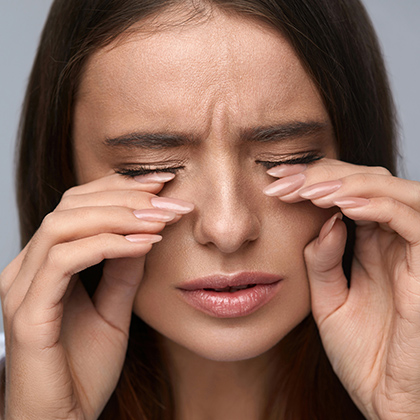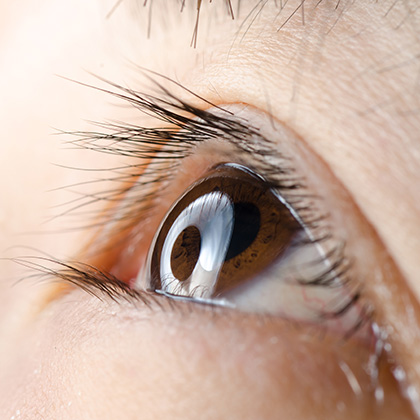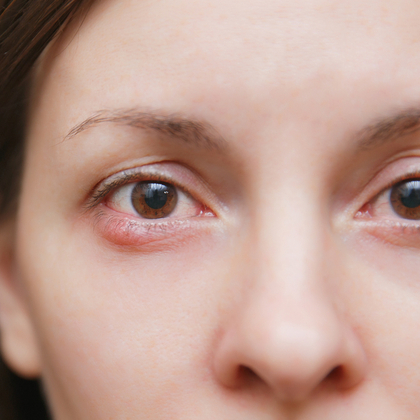Around one in 20 people who see their GP for an eye problem have blepharitis, says the National Institute for Health and Care Excellence (NICE) (i). Blepharitis is inflammation of the eyelids. Thankfully it is not usually serious, but it can feel very uncomfortable particularly if you are a contact lens wearer and it tends to recur after you ’ve had it once.
Mostly developing in middle-aged people, blepharitis can develop at any age, including in children (i). It can make your eyelids feel sore and itchy, and you may find they stick together when you wake up in the morning. Your eyelids may look swollen, crusty or greasy, and you could also experience a gritty, burning feeling in your eyes. Some people with blepharitis also find their eyes are more sensitive to light.
Blepharitis types
Anterior and posterior blepharitis are the two main types of this condition:
-
Anterior blepharitis
This can be caused by a bacterial infection called staphylococcus or by a skin condition called seborrheic dermatitis. You know you may have anterior blepharitis when the outside front edge of your eyelids, at the base of your eyelashes, is affected. -
Posterior blepharitis
This, on the other hand, happens when glands on the inside edge of your eyelids ? called meibomian glands ? are affected. These glands produce an oily substance that’s found in tears. However, they can become irritated and inflamed, and may produce too much of the oily substance, making the glands blocked.
Some people are affected by both types of blepharitis, which healthcare professionals call combination blepharitis.
In most cases, the cause of blepharitis is not known. But experts do know that it can be more common if you have a skin condition such as seborrhoeic dermatitis or rosacea (ii). Dry eye syndrome(keratoconjuncitivitis sicca) is also linked with blepharitis, and if you have both conditions your eyes may feel dry, gritty and sore.
And while it may often look unpleasant, blepharitis is not contagious. In fact, it can often be managed by practising good eye hygiene. But if you cannot control the symptoms of blepharitis yourself, it is a good idea to see your GP for a proper examination. If your symptoms are severe, your GP may refer you to an eye specialist (ophthalmologist).
How to clean your eyelids
If you have or have had blepharitis, it is important to make sure your eyelids are clean even when you do not have any symptoms to help prevent another flare-up. Keeping your eyelids clean every day can help to unblock any meibomian glands that have become clogged up as well as remove any general debris. If you are a contact lens wearer, make sure you remove them before you start the following process:
-
Apply warmth to your eyelids to help soften any crusty deposits and to make any excess oil made by the meibomian glands easier to remove. There are two ways you can do this: either use a warm compress using a cloth or flannel that has been soaked in warm (not hot) water and wrung out, or use a reusable heat bag designed for use on the eyes that you warm up in the microwave (these are available from some opticians). Place the compress or heat bag over your eyes and relax for up to 10 minutes. Some people find the reusable heat bags more effective, as they stay warm for longer.
-
After you’ve applied warmth, shut your eyes and gently massage them with your fingertips or a cotton wool bud. This helps to loosen any crusty deposits and gets any oily secretions that may be starting to block the glands moving. Massage the top lid from the top down to the edge, and the bottom lid from underneath and up towards the edge. Don’t apply too much pressure, it should feel comfortable.
-
Now clean the edge of your eyelids to remove any crusty deposits and excess oil. Boil some water and let it cool until it is warm, then add a drop or two of baby shampoo. Then dip a cloth or cotton wool bud in the water, squeeze out the excess liquid, and gently wipe along your eyelids, paying attention to the edges.
Alternatively, you can use cooled boiled water on its own without any baby shampoo, or ask your optician about products called lid scrubs. These come in the form of pre-moistened pads, foams or fluids that you apply to a sterile pad, and are specially formulated to manage eye conditions such as blepharitis and dry eye syndrome. If you are having a flare-up, clean your eyelids twice a day. Once your symptoms have improved, go back to once a day to keep your symptoms at bay.
Remember: avoid wearing eye make-up such as eyeliner if you have blepharitis especially during a flare-up and avoid rubbing your eyelids, as both can aggravate your symptoms. Also try to avoid smoky atmospheres, as smoke can make your symptoms worse too.
Treatments for blepharitis
If your symptoms do not improve with practising daily eye hygiene or if you have an infection in one or both eyelids you may need prescription medication from your GP. The main treatment comes in the form of antibiotics, either in cream, ointment, drop or tablet form.
Topical antibiotics (ointments, creams and drops)
These should be applied to the edge of your eyelids using clean fingers or a cotton wool bud. Usually two or more applications a day are needed in the first instance, but you may only need to use topical antibiotics once a day, usually after your nightly cleaning routine, once your symptoms start to improve.
If your GP or optician has prescribed antibiotic eye drops, try not to wear contact lenses, as it can cause irritation to your eye. Some antibiotic eye drops are less irritating, such as preservative-free drops, for instance, so if you want to carry on wearing your lenses, ask your GP or optician to recommend the right one for you.
Meanwhile, if you’re using an antibiotic eye ointment, be aware that it can temporarily blur your vision. If it does, avoid driving immediately after applying your ointment.
Antibiotic tablets
People whose blepharitis does not improve with regular eye cleaning and topical antibiotics or those who also have rosacea may be advised to take a course of antibiotic tablets. You may need to take antibiotic tablets for three months or sometimes for longer. Some antibiotic tablets may not be suitable for women who are pregnant or breast feeding.
Steroid eye drops
In a few cases, steroid eye drops may be used to treat a blepharitis flare-up.
Lubricants
Blepharitis is often associated with dry eyes, but using lubricants in the form of ointments, gels and drops can make your eyes feel more comfortable. There are many types and brands available, including drops called artificial tears (hypromellose), so ask your optician or your GP to recommend one that would suit you.
Anti-dandruff treatment
If you have blepharitis that’s caused by seborrheic dermatitis, it could also lead to dandruff (dandruff is seborrhoeic dermatitis of the scalp). There are many anti-dandruff shampoos and hair treatments available that may help.
Blepharitis complications
As well as being uncomfortable, blepharitis can cause other problems (though thankfully, serious complications are not common).
The main complications are as follows:
Dry eye syndrome
Many people who have blepharitis also suffer from dry eye syndrome ? a problem that happens when either your eyes do not produce a sufficient amount of tears or when the tears they do produce evaporate too quickly. Dry eye syndrome can also be caused by skin conditions linked with blepharitis such as seborrhoeic dermatitis and rosacea. Lubricating drops such as artificial tears (hypromellose) can help to soothe eyes that feel dry and sore, with or without blepharitis.
Styes
A stye is an eyelash root (follicle) that has become infected with staphylococcus bacteria, causing swelling and redness on the edge or inside of the eyelid. The swelling may also become filled with yellow pus and feel painful to the touch, and your affected eye may water. The good news is that styes tend to improve without any treatment. But if yours isn’t getting better or is particularly painful, you should see your GP.
Conjunctivitis
Inflammation of the conjunctiva the mucous membrane that covers the exposed front portion of the whites of your eyes and lines the inside of the eyelids is called . You can develop it if bacteria in your eyelid migrates to your eye and infects your conjunctiva. Also known as red eye or pink eye, it can make your eye or eyes feel itchy, burning and gritty. Treatment isn’t needed for most cases of conjunctivitis, but you may be prescribed antibiotic eye drops if your symptoms don’t improve after a week or two.
Conjunctival phlyctenules
These are small yellowish-white lumps that appear on the lower part of your eye, below the cornea (the membrane that covers the front of the eyeball, including the iris and the pupil). They are also surrounded by tiny blood vessels that make the lower part of your eye look red.
Meibomian cysts (chalazion)
If one of your melbomian glands becomes inflamed or blocked, it can cause a melbomian cyst on the inside of your eyelid. The cysts are painless unless they become infected, in which case you will need a course of antibiotics to treat them. If they don’t become infected, they usually disappear without any treatment.
Keratitis
Severe blepharitis can lead to inflammation of the cornea, which is called keratitis. The symptoms include sensitivity to light, worsening vision and eye pain. If you have keratitis, it can be sight threatening, so see a health professional as soon as possible. Thankfully, keratitis is a rare complication of blepharitis.
Eyelash and eyelid damage
In severe cases of blepharitis, problems with eyelashes can happen, including eyelashes that turn inwards and eyelashes that fall out and don’t grow back. In very few cases blepharitis can also cause damage to the eyelids that can make them turn inwards against the eye or outwards.
Blepharitis: can nutrition help?
Having a healthy diet and avoiding processed and convenience foods may help to prevent or reduce blepharitis flare-ups because it can support your health and that of your eyes in general. Certain nutrients that are also available as supplements may be particularly beneficial for those who have blepharitis, including the following:
Omega-3 fatty acids
The omega-3 fatty acids in fish oils are widely accepted to have an anti-inflammatory action, and one clinical trial suggests that omega-3 supplements may well be beneficial for both blepharitis and meibomian gland dysfunction (MGD) (iii). One of the omega-3 fatty acids found in fish oil namely docosahexaenoic acid (DHA) has also been approved by the European Food Safety Authority (EFSA) as contributing to the maintenance of normal vision (iv).
Alpha lipoic acid
Experts believe antioxidants are important nutrients for eye health because of the way they may help prevent damage to the eye caused by substances called free radicals (v). Alpha lipoic acid is a powerful antioxidant that belongs to the same group of nutrients as vitamin A, which helps to protect the cornea (surface of the eye). Lots of foods contain low amounts of alpha lipoic acid, including broccoli, Brussel sprouts, carrots, beetroot, spinach, tomatoes and red meat, particularly offal.
Anthyocyanidins
Another antioxidant substance, anthocyanidins are flavonoids, which are known to support small blood vessel health, including the blood vessels in the eyes. These are found naturally in dark red-blue plant pigments, such as those in blackberries, blackcurrants, blueberries, black and red grapes, raspberries and aubergines.
Vitamin B2 (riboflavin)
Vitamin B2 may be best known for the way it helps to convert carbohydrates to energy in the body. But it also plays a part in antioxidant production by helping with the conversion of an antioxidant called glutathione. Levels of other antioxidant enzymes are also affected by vitamin B2. including superoxide dismutase, catalase and glutathione peroxidase. Meanwhile, the EFSA has upheld claims that vitamin B2 contributes to the maintenance of normal vision (vi). You can find vitamin B2 in a wide range of foods such as goat’s cheese, almonds, red meat, oily fish, eggs, mushrooms, spinach, sesame seeds and seafood.
Astaxanthin
Like omega-3 fatty acids astaxanthin is believed to have anti-inflammatory properties (vii), which suggests it may be helpful if your eyes are red and swollen. Classed as a carotenoid, astaxanthin is a particularly powerful antioxidant (viii). It’s derived from a freshwater microalgae called Haematococcus pluvialis (it’s the red pigment in the algae that give certain fish and shellfish their red or pink colour – salmon and lobster, for instance).
You can get astaxanthin in your diet by eating foods such as salmon, lobster, shrimp, crawfish and crab, but it’s unlikely you’d be able to eat enough of these foods to get the amount of astaxanthin needed to see any real vision benefits. Taking a high-quality supplement, however, would provide a more beneficial dose of astaxanthin – plus it’s a good option for anyone who doesn’t like eating fish or seafood.
You can read more about astaxanthin and how it benefits vision health in our article Astaxanthin and Eye Health: The Potential Benefits.
For advice on a range of other health concerns, our health library has a number of helpful articles.
References:
-
Available online: https://cks.nice.org.uk/blepharitis#!backgroundSub:2
-
Available online: https://patient.info/doctor/blepharitis-pro
-
Macsai. MS. The Role of Omega-3 Dietary Supplementation in Blepharitis and Meibomian Gland Dysfunction. Trans Am Ophthalmol Soc. 2008;106:336-356. Available online: https://pubmed.ncbi.nlm.nih.gov/19277245-the-role-of-omega-3-dietary-supplementation-in-blepharitis-and-meibomian-gland-dysfunction-an-aos-thesis/
-
Available online: https://efsa.onlinelibrary.wiley.com/doi/epdf/10.2903/j.efsa.2010.1734
-
Available online: https://www.aoa.org/patients-and-public/caring-for-your-vision/diet-and-nutrition
-
Available online: https://efsa.onlinelibrary.wiley.com/doi/pdf/10.2903/j.efsa.2010.1814
-
Miyachi M. et al., Anti-inflammatory effects of astaxanthin in the human gingival keratinocyte line NDUSD-1. J Clin Biochem Nutr. 2015 May;56(3):171-178. Available online: https://www.ncbi.nlm.nih.gov/pmc/articles/PMC4454080/
Park JS. et al., Astaxanthin decreased oxidative stress and inflammation and enhanced immune response in humans. Nutr Metab (Lond). 2010;7:18. Available online: https://www.ncbi.nlm.nih.gov/pmc/articles/PMC2845588/ -
Miki W. et al., Biological functions and activities of animal carotenoids. Pure Appl. Chem. 1991;63:141-6. Available online: https://www.researchgate.net/publication/244741723_Biological_Functions_and_Activities_of_Animal_Carotenoids
Related Posts
Disclaimer: The information presented by Nature's Best is for informational purposes only. It is based on scientific studies (human, animal, or in vitro), clinical experience, or traditional usage as cited in each article. The results reported may not necessarily occur in all individuals. Self-treatment is not recommended for life-threatening conditions that require medical treatment under a doctor's care. For many of the conditions discussed, treatment with prescription or over the counter medication is also available. Consult your doctor, practitioner, and/or pharmacist for any health problem and before using any supplements or before making any changes in prescribed medications.

Christine
Christine Morgan has been a freelance health and wellbeing journalist for almost 20 years, having written for numerous publications including the Daily Mirror, S Magazine, Top Sante, Healthy, Woman & Home, Zest, Allergy, Healthy Times and Pregnancy & Birth; she has also edited several titles such as Women’ Health, Shine’s Real Health & Beauty and All About Health.
View More



